COMPETITION IN RAIL FREIGHT TRANSPORT
We at the VAP are committed to a fair, competitive freight transport system. To this end, we monitor, among other things, modal shift and lobby politicians for non-discriminatory rail.
Informative
Rail Freight Transport Vision of the Advisory Group on the Development of Rail Freight Transport, 2022
Future rail freight transport in the area / wagonload transport
- Interview in RailBusiness, 21.11.2022: Frank Furrer zur Fortführung des Wagenladungsverkehrs
- Media release, 2.11.2022: Unterstützung für einen starken Schienengüterverkehr in der Fläche
- 2.11.2022: Bundesrat gibt zwei Varianten in Vernehmlassung
- Erläuternder Bericht zur Vernehmlassungsvorlage, BAV
- Faktenblatt Digitalisierung
- Faktenblatt Schienengüterverkehr
- Position paper to KVF‑N, 22.6.2022: Future of rail freight transport in the countryside
Legal
Summary of a study commissioned by the shipping industry
- Study «From integrated to market-oriented railways» in German or in French
Modal shift report 2021
- Federal Council report on modal shift of November 2021 (in german)
- Blog articel: Modal shift: In transit on the right track
Transport of dangerous goods
Archive
Relocation report 2019 – industry calls for additional measures
- Bericht des Bundesrats über die Verkehrsverlagerung vom November 2019
- Positionspapier der Branche
- Position der Branche (Präsentation)
- Position der Branche (PDF)
- Medienmitteilung der Branche
- BAV: Botschaft zum Bundesbeschluss über eine Erhöhung und Laufzeitverlängerung des Zahlungsrahmens für die Förderung des alpenquerenden Schienengüterverkehrs
- BAV: Bundesbeschluss über eine Erhöhung und Laufzeitverlängerung des Zahlungsrahmens für die Förderung des alpenquerenden Schienengüterverkehrs
- BAV: Faktenblatt Sinkende Lastwagenzahlen und hoher Marktanteil der Bahn
- BAV: Faktenblatt Verlagerungswirkung der NEAT
- BAV: FAQ Verlagerungsbericht 2019
- BAV: Verkehrsentwicklung im alpenquerenden Güterverkehr infolge Fertigstellung der NEAT
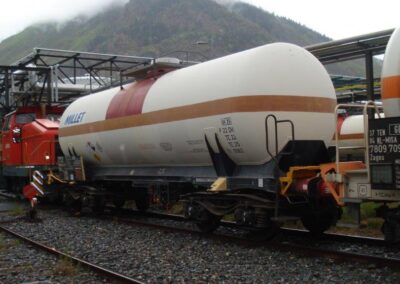
Subsidising wagonload traffic: preventing distortion of competition and discrimination
We comment on the Federal Council’s consultation draft “Further development of the framework conditions for Swiss freight transport”. We critically assess the proposals from the point of view of freight rail customers and demonstrate the necessity of a legal independence of system transport.
Yes and but to variant 1
With variant 1, the Federal Council wants to digitalise rail freight transport with automatic digital coupling (DAK). In this way, it positions rail as part of multimodal logistics. Accompanying this, it provides for spatial planning measures, investment aid and transhipment and loading incentives that cushion the additional costs of the system break between rail and other modes of transport. Until automation is implemented, the Federal Council wants to compensate for the uncovered costs of system traffic. We welcome the thrust of variant 1 in essence, but have reservations and note a fundamental need for adjustment.
Making the subsidised first/last mile independent
We want to and must make system transport more sustainable. This requires a redesign of all processes, incentive instruments, market mechanisms and interfaces within multimodal freight logistics. The goal must be a self-sufficient and market-based system that does not discriminate against any freight railways and is reliably available to shippers.[1] Until this new concept is implemented, we agree to temporary financial aid for SBB Cargo’s network traffic. This financial aid is based on performance-related, competition-neutral and non-discriminatory incentives – and on making the first/last mile independent in a legally independent SBB company. This is the only way to guarantee Switzerland’s security of supply and the future viability of the railways.
Preventing distortion of competition and discrimination
By transferring responsibility for system traffic to SBB Cargo, the Federal Council is monopolising around 70% of the freight transport volume. At the same time, SBB Cargo is also the main provider of block train and combined transport services. This combination of interests can lead to discrimination against system and block train customers on the one hand, but also to distortions of competition vis-à-vis other providers of block train and combined transport services on the other – irrespective of the compensation paid to system transport. This consists of the nationwide service of transhipment and loading facilities and should therefore be legally independent. Since the corresponding services and resources are already combined in an independent organisational unit today, the transformation effort would remain low. However, the Federal Council would have to specify Art. 9a para. 7 of the Freight Transport Act (GüTG).
Consistently supervise new system operator
During the limited phase of public compensation, but also afterwards, the system operator should be consistently monitored in terms of performance, quality, productivity and costs. Care must be taken to ensure that the financial aid is quickly reduced and that SBB Cargo’s business model is modernised. This prevents disadvantages and ensures smooth, nationwide system traffic in the long term. Targeted monitoring of the development of volumes and customer structure should guarantee the latter in particular in the long term. Such monitoring requires an amendment to Art. 9a GüTG.
Additional background information and opinions can be found in our response to the consultation on the «Weiterentwicklung der Rahmenbedingungen für den Schweizer Gütertransport».
[1] Cf. video “Rail freight transport of the future”: www.cargorail.ch/#video
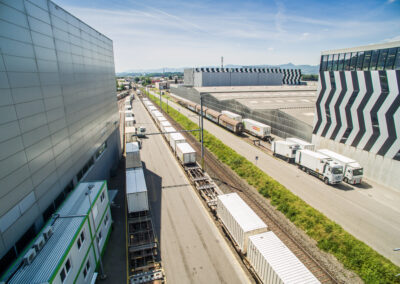
Outsourcing the last mile and making it non-discriminatory
That’s the point:
- Why free access to the last mile is important
- Preventing discrimination instead of fighting it
- Redistributing and refocusing forces
Importance of the last mile
Serving the last mile (local delivery) is solely in the hands of a local or regional provider. Accordingly, non-discriminatory access to the last mile determines whether an offer is competitive in the main run or not. Whoever provides services in local delivery by rail is obliged to do so in a non-discriminatory manner. This is the intention of Article 6a of the Freight Transport Ordinance (see box).
Article 6a of the Freight Transport Ordinance (GüTV)All companies that provide (partial) services over the last mile must provide their local delivery services by rail in a non-discriminatory manner. This means that they must also provide their services for third parties, provided that capacities are available for this. In addition to the freight railways, this obligation concerns siding operators with their own rolling stock and personnel, specialised personnel leasing companies and shunting service providers. Shunting and other services related to short-distance delivery, such as technical inspections or brake tests, are considered last-mile services.> Further information from RailCom in German or French |
Preventing discrimination instead of fighting it
Art. 6a GüTV relies on regulations, market controls and legal remedies. However, it would make more sense to prevent discrimination by having a single provider ensure the service of the first/last mile. Ideally, this would be the infrastructure manager who does not otherwise provide transport services. In a market environment, rail freight access to sidings, local and central marshalling yards, free loading facilities or terminals is regulated in a non-discriminatory manner. The allocation of train paths and the operation of system-relevant infrastructures are the responsibility of independent institutions. System leadership by a single large operator – as is currently the case with SBB Cargo – does not exist. The boundaries between single wagonloads and block trains are abolished, and the last mile is managed by an infrastructure manager.Reorganisation of forces
In order to achieve the ideal state described above, roles have to be redistributed and forces have to be bundled. Such a reorganisation will only succeed if the following framework conditions are created:- SBB Cargo retains its role as network provider for the time being. It is responsible for the planning of network traffic and ensures the efficient bundling of traffic with individual wagons or wagon groups. In providing the services, it limits itself to the main transport runs between formation and marshalling yards, insofar as it does not procure these from third parties.
- The entire railway infrastructure such as the network, combined transport terminals and local marshalling yards are freely accessible to freight railways.
- The service of the first/last mile is a non-discriminatory service of the infrastructure managers for all freight railways. The system-relevant resources of SBB Cargo, such as traction units, shunting teams, shunting tracks/stations, shunting services or internal operational changes, are available to these.
- This creates competition with equal players and transparent costs. You can read more about this in our publication «From integrated to market-based railways» (in german).

«You won’t go far without courage»
Dr Heiko Fischer presides over the International Union of Wagon Keepers UIP. The former VTG boss talks to the VAP about the future of European rail freight transport and the digital transformation of the rail sector. He would like to see more enthusiasm for the latter and explains why he considers the discontinuation of single wagonload traffic in Switzerland to be fatal.
Dr Fischer, where do you see the biggest challenges and where do you see the levers for the European rail market?
There are quite a few. The railway infrastructure is outdated or in many places a patchwork quilt that has grown historically. There are still borders between the subsystems. Every year that nothing is done, the problem grows, because the infrastructure continues to age unwaveringly. This is where I see the adjusting screw in the coordination of expansion plans, relief routes and corresponding construction measures throughout Central Europe. It is true that the trans-European networks pursue this integrative approach. But secondary lines and fine distribution networks must not be excluded when it comes to investment allocation, expansion and renewal planning, train control systems and regulation.
I see a further control variable in the complete digitalisation of the railway sector, starting with the networking of the infrastructure via the rolling stock to the operational business. There should be a standardised logic with corresponding interfaces. As a result, electrification can take place in a measured and targeted manner. Lightly loaded routes could also be served by hydrogen-powered hybrid locomotives.
«Rail freight relies on public funding for certain urgencies, such as basic digitisation, infrastructure development, electrification, implementation of digital automatic coupling DAC and other time-critical leap innovations.»
Available capital is also a cornerstone. The railway market does not only need sufficient private capital. For certain urgencies, it depends on public funds, for example for basic digitisation, infrastructure expansion, electrification, the implementation of the digital automatic coupler DAC and other time-critical leap innovations. Such investments are beyond the financial powers of the private sector and most state railways. After all, nobody wants to invest in technologies that will only bear fruit in the next decade, perhaps even with other players in the railway system. This brings me to another set screw: we also need an anchored economic understanding of the mechanisms of rail freight transport among governments, regulators and politicians. This requires a rethink on the part of all those involved in the system.
In what way?
The rail sector is not exactly known for thinking proactively and implementing new things quickly. Many see themselves as victims, be it of the past, of wrong decisions, of the road, of the weather or of anything else. In my opinion, that absolutely has to change. After all, we don’t haul goods trains around because we enjoy it, but because we want to generate added value for shippers and our communities. The players in rail freight transport need to put the customer back in the centre of their attention and to be aware of their future needs. For the upcoming change to actually happen, we need more of a start-up mentality, a “can do” attitude.
What innovations have you driven forward at VTG in recent years, and which of them were groundbreaking?
VTG Connect spontaneously comes to mind. This telematics technology collects relevant data on the entire fleet and many transports. It creates the basis for efficient digital fleet management, because it makes data usable for customers, freight railways and maintenance purposes. With this innovation, we have, so to speak, launched the entry into real-time data transmission in freight transport as envisaged by the DAC.
What importance do you attach to the DAC in the future?
The DAC is a catalyst for the digital transformation of the rail sector. With it, a new control logic and real-time data flows can be mapped. We are a long way from that today. The DAC does more than automate the coupling process. It networks train drivers, cargo, cargo carriers and energy, i.e. electricity. The potential of this combined with new digital technologies is immense. The DAC is not only an intelligent train and load control system, but also a facilitator for other digitalisation initiatives such as digital data, train control and booking platforms.
«There will certainly be several platforms, because as before, each company will collect information that it cannot or may not share. One or even more of these platforms will emerge as central hubs that manage the operational railway business.»
What role will these play in the future?
There will certainly be several platforms, because as before, each company will collect information that it cannot or may not share. One or even several of these platforms will emerge as central hubs that manage operational railway operations. As such, they will provide freight operators with reliable information that can be used to reduce the distances between trains, calculate time windows and put more tonnage on the track per unit of time. A pan-European electronic freight traffic control system must not come from a tech giant à la Google, but should develop from within the rail sector itself. In this way, we show innovative strength vis-à-vis other modes of transport.
Perhaps in the future there will even be a superordinate body like Eurocontrol for the central coordination of air traffic control. Such a cockpit could control European rail freight traffic, give the train drivers certain instructions, intervene if necessary and later allow autonomous trains to run. However, such quantum leaps are only possible if digital technologies with artificial intelligence are implemented and take effect. Only they bring dynamism and ensure the necessary speed, which is absolutely central to the success of the digital transformation.
How could rail freight transport in Europe be developed sustainably?
With something that brings the economic impact of freight transport down to a common denominator and to which all players commit. I can imagine that one day there will be a long-term master plan in the sense of a self-regulating yet binding declaration of intent. All participating state and non-state railways would have to co-sign it. This master plan could state that they are working together towards a modal shift. I would remind you of the General Contract of Use (GCU) of 2006, which regulates the interaction between wagon keepers and railway undertakings as wagon operators. The advantage of a supranational agreement without the character of law is that it can be supplemented or adapted quickly and easily. The accesses to the NRLA are the best example of what should not happen: The community of railway states, including Switzerland, has committed itself to expanding the north-south axis. When Switzerland opened the NRLA tunnel, other states had not even started planning. A master plan for European freight transport could make this intention more binding and make it clear that the Green Deal and modal shift goals are meant seriously. Today it is still a pipe dream. Most of the time, everyone agrees with the basic demands. But as soon as it comes to working out something concrete from a single source, opinions diverge.
What do you think of the Federal Council’s report on ‘Rail Freight Transport in the Area’? What would it mean if the Federal Council abolished it?
In my opinion, that would be the biggest mistake in transport policy for decades. Switzerland proves that wagonload traffic works. However, it is still too expensive. But if train formation and separation are automatic, the train line is digitally controlled and the market benefits from the many advantages of digital offers, then the costs will also go down – and the need for subsidies will decrease. The Federal Council should think about how to make the offers more attractive for freight rail customers. To call the whole thing off even before digitalisation bears fruit would be criminal. Transferring rail freight to trucks also costs money and not every freight can be containerised for block trains. In my opinion, the Swiss government should be more confident in this area. Those who lack courage have already lost.
We at the VAP are members of the UIP. How would you describe the VAP?
It is a valuable member association of our European wagon keeper family. I perceive it as innovative and opinionated. Because of its unique membership structure, it has a special weight with us. The VAP represents not only the five largest Swiss wagon keepers, but also the interests of shippers, sidings and representatives of multimodal logistics chains. This diversity generates impact and a wealth of ideas among us, and I consider it a valuable strength. With its member diversity, the VAP can focus its demands more holistically on the users and place them with greater authority. I support the VAP’s client-centred approach, which involves the end-user in the discussion and decision-making process. Europe can benefit from the Swiss experience with wagonload traffic or the performance-based heavy vehicle charge. It is often seen as a “minilab” that mirrors issues for us. Furthermore, the VAP shows us in an exemplary way how to convince the population or how to shape something positively as a community.
What can the VAP do better?
Better is always possible. My appeal is not only to the VAP, but to all associations and people involved in transport policy. We need committed people who are willing to formulate interests with a view to the future. There are enough of those who think in terms of quarterly balance sheets. But that is no way to win the future.
What do you wish for this future?
More interest, more confidence. More enthusiasm. Shippers should be eager to put even more tonnes on the rails. This is the only way we can achieve the ambitious modal shift and climate targets. The population should realise how important rail freight transport is – and that it costs money. After all, an unchecked flood of lorries is not an alternative. I hope that you from the VAP and we from the UIP will continue to stand up for this departure day after day.
Dr Fischer, thank you very much for the informative interview.
|
Dr. Heiko Fischer Dr. Heiko Fischer served VTG for a total of more than 25 years until 2021, including more than 17 years as Chairman of the Executive Board. Since 2015, he has been President of the umbrella organization International Union of Wagon Keepers UIP, based in Brussels, as he was from 2004 to 2007. This represents more than 250 freight wagon keepers and maintenance centres with more than 223,000 freight wagons, which cover 50% of the tonne-kilometres in European rail freight transport. Dr Heiko Fischer’s former employer VTG AG operates the largest private freight car fleet in Europe with around 88,500 rail freight cars. In addition to hiring out freight wagons and tank containers, VTG offers multimodal logistics services and integrated digital solutions. |
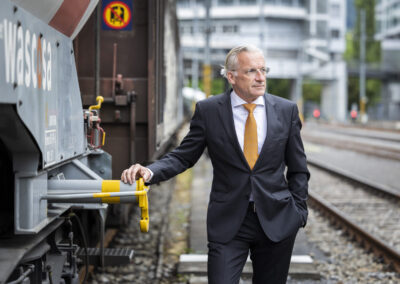
«We want to be faster and better than the others in the future as well.»
In June 2022, the takeover of the family business WASCOSA by Swiss Life and Vauban was announced. We wanted to know more about the background to this sale and the vision of WASCOSA from the former owner and future Chairman of the Board of Directors Philipp Müller.
Mr Müller, the news of the sale of your successful family business came as a surprise. What will change?
Philipp Müller: Less than you might think at first glance. With this step we have secured the future of WASCOSA. Of course there will be a change from a family-run to an investment-driven company. But the spirit of WASCOSA will remain. We want to continue to act faster and better than others, to be successful as a team and to put customers’ interests before our own. These goals are demanding, but doable.
What prompted you to take this step?
The succession plan and securing the future of the company. Neither of our children was interested in succeeding me. So we had to find an external solution to this question. Eight years ago, we had already hired a CEO from outside the family, Peter Balzer. In addition, our market is currently undergoing an enormous shakeout. Of the ten largest car rental companies in Europe, we are the only ones who have not experienced a merger or takeover. Those who are still in the game are constantly getting bigger, making major long-term investments and taking high financial risks. We simply needed more financial strength for WASCOSA to be able to survive as an SME in this market. We found these strong financial partners in Swiss Life and Vauban.
What other solutions were on the table?
At first we considered a minority shareholding by third-party shareholders. However, this did not result in an optimal solution for the parties involved. Selling to a competitor was never on the table. In the end, long-term cooperation with a strong financial partner proved to be the most sustainable.
«WASCOSA has established itself from a small, unknown rental company to a successful supplier of freight car systems throughout Europe through innovation, customer proximity and agility.»
What experiences from the past will shape the future of the company?
WASCOSA has established itself from a small, unknown rental company to a successful provider of freight car systems throughout Europe through innovation, customer proximity and agility. We want to maintain this latter position. One example of our innovative strength: there is currently a strong trend towards modular freight car concepts. We introduced such concepts 15 years ago. Now that the trend is catching on, we are ready for the market. In the last 60 years of our company, an uncompromising customer orientation has made the difference in our daily business. We want to keep it that way too. It is in the interest of the new owners that WASCOSA remains at its core what it has always been: an innovative and customer-oriented company.
How will you master this change process?
The participation of Swiss Life and Vauban as third-party shareholders was derived from an intensive strategy process with around 15 employees. After the decision was made, we introduced the new shareholders to the company at a one-day event. Throughout the entire strategy process, we wanted to avoid uncertainty, mistrust and false assumptions on the part of management and employees. We succeeded in doing so, and we are doing everything we can to ensure that we also succeed under the new ownership. CEO Peter Balzer and I will still be on the Board of Directors. This is a strong message with regard to continuity and the future of WASCOSA.
«The DAC is a key project with enormous potential to move freight wagon transport forward.»
Where do you see the most urgent need for action in rail freight transport?
There are different starting points. We need sufficient capacities on the network, i.e. more train paths. In addition, country-specific obstacles should be removed. And finally, rail freight transport is dependent on targeted financial support to get innovations rolling, for example the digital automatic coupling (DAC).
Speaking of DAC: what do you think about it?
It is a key project with enormous potential to move freight wagon transport forward. However, we have little influence on this highly political topic. We have been working on the electrification of freight wagons for several years. Here, of course, the DAC gives us an additional boost.
Is the real added value of the DAC recognised by the industry?
Our industry is not too keen on innovation and also not very future-oriented. The automation of coupling by the DAC has arrived. I am not so sure about its potential for digitalisation. As always, it probably first needs someone to lead the way and make the efficiency gains clear.
You have been involved in the VAP’s Executive Committee (GLA) for years. How do you describe the work of the VAP?
The VAP is characterised by a high level of competence and a pleasant working relationship. The association’s activities are driven by the cause and not by the ego of individuals. The VAP is the leader in some areas. This is shown by the high level of participation at home and abroad in events such as the forums. This interest proves that the VAP takes up political, economic or legal issues proactively and constructively. I found the get-together at the GLA very positive. In the dialogue with SBB, the association shows staying power. Here, passenger transport comes first, then infrastructure, then real estate and only then rail freight. That makes it all the more important to keep at it. The patience and constant cooperation of Frank Furrer’s team stand out.
What strengths do you attribute to the VAP?
One of its main strengths is the large number of shippers among its members. The VAP networks all the players in freight transport. In addition, it offers the shippers’ industry a highly interesting and relevant platform. I think that you can only make successful policy if you represent all interests.
How has the VAP supported you and your WASCOSA?
We have had very good experiences with the VAP. It has even supported us competently and successfully all the way to the Federal Court.
What else would you like to see from the VAP?
That it becomes more visible in the media. The VAP could appear more prominently as an opinion-leading expert on rail transport and thus increase its public profile, just like the TCS or ASTAG.
To whom would you recommend cooperation with the VAP?
Everyone who is interested in rail freight transport. I am thinking above all of associations from other modes of transport. For a long time now it has no longer been just about rail versus road, but about sensible multimodal co-existence.
What has not yet come up in this conversation?
The topic of sustainability. Rail freight transport is one of the most important drivers and carriers of sustainable transport. Incidentally, this was also one of the reasons why I took over from my father-in-law at WASCOSA 30 years ago.
Mr Müller, thank you very much for the interesting interview.
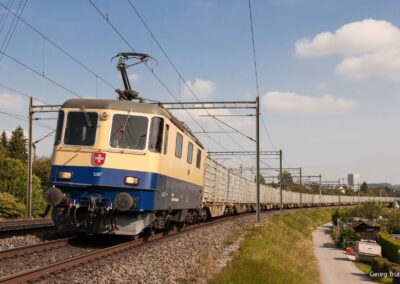
TR Trans Rail AG – a multimodal success story
We at the VAP are committed to competitive rail freight transport. In the meantime, several private RUs and VAP members operate important transports. We are happy to introduce them and their core competences. Let’s start with TR Trans Rail AG.
Between mid-September and the end of December is harvest time for sugar beet – a multimodal, logistical challenge for all involved. Here, rail plays to its strengths, especially on medium and longer distances, and delivers large quantities reliably and on time to the two plants in Aarberg and Frauenfeld.
As a long-standing logistics partner of Schweizer Zucker AG, TR Trans Rail AG’s cargo transports reach a peak in the last quarter of each year. During this time, a complex logistics project is ramped up for transport to the sugar factories. At the loading points, the rail wagons are loaded by the farmers and then transported by rail. Since the 2021 season, TR Trans Rail AG has been the sole national logistics partner of Schweizer Zucker AG in the area of rail transport, another milestone in its corporate history.
Thanks to the experience of the past seasons, meticulous planning coupled with a high degree of flexibility, the orders are handled smoothly. If, for example, drought or viral yellowing have a negative impact on yield and sugar content, various trains have to be rerouted at short notice. Only with the flexibility of everyone involved is it possible to optimise the utilisation of the two plants.
Shortly before Christmas 2021, the last load of beet reached the Frauenfeld sugar factory. For 100 days, TR Trans Rail AG transported around 555,000 tonnes of beet to the sugar factories in Aarberg and Frauenfeld with over 500 trains.
«The transport by rail and the cooperation with the partners involved mostly worked smoothly. Thanks to the rail transports, around 90,000 road kilometres could be saved. That corresponds to a distance of about two circumnavigations of the earth,» explains Peter Koch, who is responsible for the sugar beet transports east.
TR Trans Rail AG relies on the VAP when it comes to overarching know-how in rail freight transport.
André Pellet: To help our customers find new transport solutions for their wagon loads, we wanted to learn more about their needs, possibilities, but also hurdles. A business partner therefore recommended that we contact the VAP, which we already knew. The contact was quickly established and the cooperation started quickly and without complications.
What would you tell a colleague about the VAP?
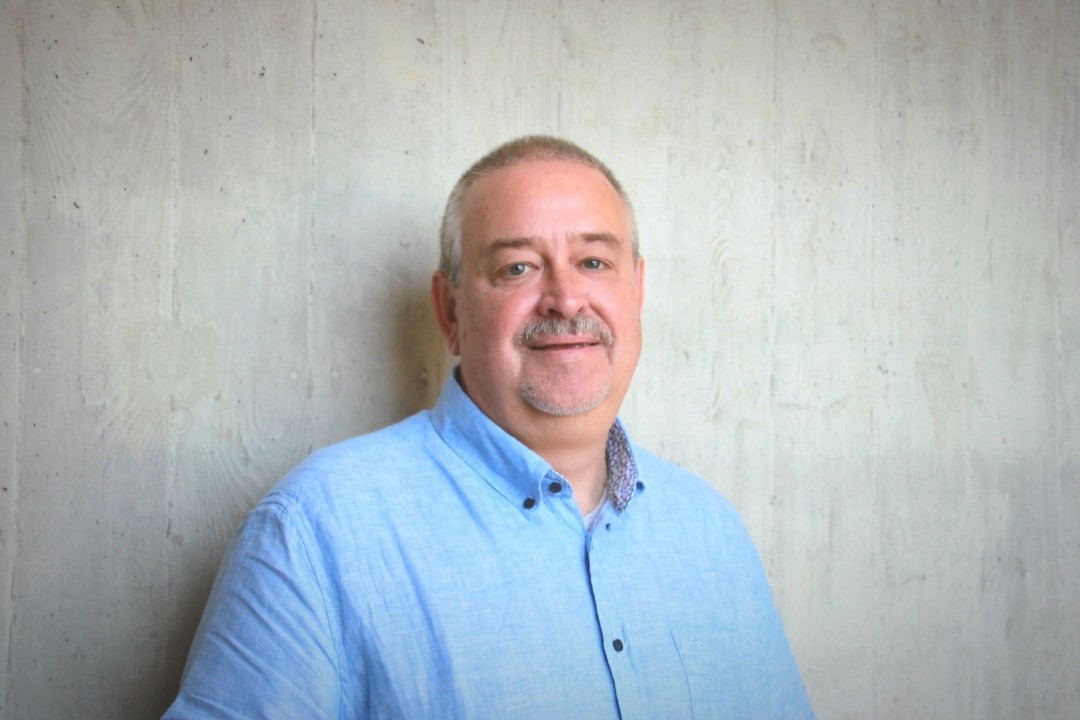
André Pellet, Managing Director TR Trans Rail AGThe VAP is an extremely useful platform for the maritime industry. For only together can the urgent issues of freight transport by rail be tackled.
The rail freight system is extremely complex and therefore very demanding. Each customer or provider has different needs. But only the whole unit, bundled in an association, has the chance to master the challenges.
Where do you see the most urgent need for action to promote rail freight transport?
The transport policy framework must be right for the freight railways. The tightly organised railway organisation must not hinder the flexibility to find good transport solutions and the effort must remain within an economic measure. The ever leaner infrastructure must not restrict us any further.
What do you wish for the future of rail freight transport in Switzerland?
The railway should increasingly act as a unit vis-à-vis the road. The various service providers and private railway companies have different possibilities and each could contribute something to the implementation and handling of transports. The railways should not see themselves as competitors, but should contribute their individual strengths and thus offer holistic and customer-oriented solutions.
Thank you very much for your answers, André Pellet!
|
Information about TR Trans Rail AG: As a Swiss rail transport company, TR Trans Rail offers a wide range of offers and services with various domestic and foreign partners. Thanks to many years of experience, they are specialists in the areas of freight transport, modern services, train nostalgia, group charter trips, accompanied trips and themed event trips. |
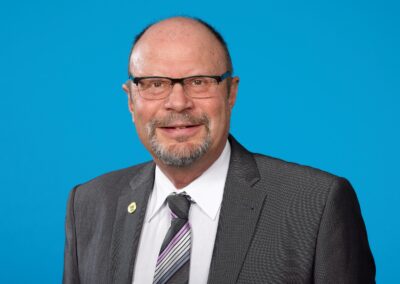
In the interview: Matthias Grieder
VAP: Mr Grieder, what is your collaboration with the VAP like?
Matthias Grieder: We have regular dealings with General Secretary Frank Furrer. For example, he is the representative of the Ristet-Bergermoos track cooperative and has represented it in a joint development project for this industrial area on the municipal territory of Urdorf and Birmensdorf. He has also been involved in the drafting of the partial revision 2022 of the cantonal structure plan and is always involved in various logistics-related working groups. Frank Furrer brings both the perspective of the siding owners and the overall national view of multimodal logistics. He supports us with his enormous expertise and his extensive professional-political network. I find this cooperation very pleasant and fruitful.
Where do you see the most urgent need for action for rail freight transport?
In my opinion, the most important and at the same time most difficult task is to secure rail/road transhipment areas in urban areas. Here’s an example: where the “Europaallee” now stands behind Zurich’s main railway station, there used to be a postal distribution centre with ten tracks. With the redevelopment of the area, the entire supply infrastructure as well as large logistics areas that would have been important for ensuring the future supply and disposal of the city of Zurich were lost. Freight traffic and logistics facilities are moving out of the city and are increasingly being displaced to the Mittelland. These distribution centres are often not accessible by rail. As a result, more and more trucks and delivery vans are driving from there into the city, which puts additional strain on the congestion belt around the agglomerations.
The Spatial Planning Act also requires denser building in existing settlement areas. The additional traffic caused by population growth must be handled on existing transport areas. This means that these areas must be used more efficiently and areas must also be made available for supply and disposal. The more densely one builds, the more important it becomes to design attractive outdoor spaces. A ground-level supply system impairs this attractiveness. That is why it is important to check early on in the site planning process how above-ground areas can be relieved of delivery traffic and how delivery and waste disposal can be integrated into underground facilities. Good examples of such solutions are the new Circle at Zurich Airport or the Sihlcity shopping centre.
What is the situation with the sidings?
The problem is similar here. Sidings and switches are constantly being dismantled and their service reduced. This creates a downward spiral: fewer tracks, less rail transport volume, less rail loading, less single wagon loads, less demand-oriented rail services. On the other hand, this means more road transport, more traffic jams, more noise and more CO2. In the long term, this trend must be reversed.
How could the problem be solved?
We need solutions that bundle shipments even more and bring them efficiently through the congestion belt into the centres. Approaches to bypass or drive under the congestion. We also need service concepts for fast and direct service. And we need better financial incentives that strengthen the railways and do not allow single-wagon load traffic to dwindle. With its excellent infrastructures, the railway has a great opportunity here and can fulfil this task. But new innovative modes of transport, such as the digital overall logistics system Cargo Sous Terrain (CST), can also transport large quantities without placing an additional burden on road transport. All these systems can be linked via common digital platforms and made even more efficient.
How do such solutions come about?
Only if all parties completely rethink and cooperate in partnership. Unfortunately, today every company calculates for itself in isolation and is focused on short-term profit maximisation. The railways concentrate on the profitable block train traffic and neglect the costly single wagon traffic, which can contribute significantly to a shift from road to rail. Road hauliers focus their fleets on the most cost-effective production, usually with smaller vehicles, and optimise their tours internally. This is despite the fact that vehicle kilometres could be reduced through cooperation with competitors. Real estate strategies or concepts of both private landowners and the public sector do not allow for innovative solutions for a vertical division of use and thus prevent solutions for a space-saving and efficient supply and disposal in urban areas.
A networked way of thinking is missing in the economy, in politics, in administrations and also in the training of transport and spatial planners.
Has the pandemic not triggered a rethink?
Yes, Covid-19 has made people more aware of the relevance of a functioning supply system. The topic of freight transport and logistics has become much more important. Experts had been dealing with these complex interrelationships long before the pandemic, and politicians are also becoming more and more aware of the issue. We try to draw attention to these interrelationships again and again. Sometimes even with success, as for example with the Sihlcity shopping centre on the site of the former “Zürcher Papierfabrik an der Sihl” in Zurich-Wiedikon. Here, the planners have integrated the supply and disposal systems into the basement right next to the garage entrance. From there, it is finely distributed vertically upwards. This is exactly the direction we have to think in when planning sites: away from pieces of cake and towards layers of cake. In this way, a combined use of urban or peri-urban areas becomes possible.
How can transshipment areas and locations be secured in the long term?
Logistics areas in urban areas are rare, and there will hardly be any new ones. The public sector is trying to secure existing transshipment areas through entries in the structure plan. However, these planning specifications are not binding on the property owner. The only way to secure land, to which private landowners are also obligated, would be through a corresponding zoning ordinance or through an increased purchase of the corresponding land by the cantons and cities. These strive for longer-term objectives with a longer planning horizon, such as securing the supply and disposal of goods, and are not so profit-driven.
How could the economy be more involved in the preparation of spatial planning concepts?
The inclusion of economic actors in the development of sites is central to the future of freight transport. After all, they have to implement site development. In the Canton of Zurich we already involve the business representatives in the analysis phase within the framework of working groups, although as a canton we have no legal mandate for freight transport planning, but only act in an advisory and supportive capacity. In the canton of Zurich we have laid down guidelines for the development of freight transport in a cantonal freight transport and logistics concept. We are certainly playing a pioneering role here. But other cantons such as Aargau, Bern, Vaud or Basel-City are also acting in a progressive manner. We learn from each other through regular exchanges via the SBB Cargo platform and the freight transport group of the Swiss Association of Cities.
In your opinion, what does optimal utilisation of the infrastructure by passenger and freight traffic look like?
I think that we should continue to pursue and optimise the current approach with separate train paths for passenger and freight traffic in the network utilisation concept. I am rather sceptical about a flexible allocation of train paths, because freight traffic could literally get lost in the process. The need for infrastructure expansion has been recognised, as the expansion step 2040 shows.
Where do you see the biggest tasks in infrastructure?
In the further development of the infrastructure, the special needs of freight transport must be taken into account. The Zurich suburban station node is already completely overloaded today and rail traffic in the Zurich area will continue to increase. Therefore, bypasses must be created, such as the freight tunnel from the Limmattal marshalling yard into the Furttal and on towards eastern Switzerland. Rail freight transports coming from the Mittelland and wanting to continue in the direction of Knonauer Amt also have to make a U‑turn in the Zurich preliminary station with a hairpin bend. This places an additional burden on the infrastructure several times over. Shortcuts” are needed here to bypass hot spots. For example, the Limmattal marshalling yard could be connected directly to Zug and Lucerne via Knonauer Amt. Such projects are of course enormously expensive and can only be implemented in the long term. Nevertheless, the planning course must already be set today.
What do you wish for the future of Swiss rail freight transport?
I very much hope that the opportunities offered by rail for shifting traffic from road to rail will also be exploited in national transport. This requires a trend reversal with faster and more efficient service concepts, especially in single wagonload traffic. Innovative service concepts that are demand-oriented and efficient are needed here.
What are these?
Digitalisation offers opportunities that are currently not being exploited in rail freight transport. For example, freight railways know via digital codes exactly when, where and for how long their goods are parked. They should make this knowledge available to their customers in the form of shipment tracking throughout the entire transport chain from sender to recipient. This would significantly increase their attractiveness.
Digitalisation and automation are also crucial for the competitiveness of rail freight. Of course, short distances of a few kilometres, as we often encounter in Switzerland, are not very suitable for rail. But if you automate certain processes – for example with the Digital Automatic Coupling (DAK) or through automated reloading of swap bodies – efficiency could be significantly increased. Private wagon owners would have to implement such solutions in order to keep their fleets more profitable and to shorten running times.
Why does freight rail have such a hard time being competitive?
That is a difficult question. One would have to analyse very carefully why rail freight is so uncompetitive and which measures are effective for more attractive offers or lower costs. Such a study could be a task of the VAP.
Speaking of the VAP: What could we do better?
I know Frank Furrer and I know what the VAP logo looks like. But I hardly perceive the VAP as an overall organisation. Here I see potential for optimisation. Moreover, I am always invited to interesting and meaningful events. But for us administrative staff, the administrative effort for the approval of an event with costs is so great that we often refrain from participating. That is actually a pity.
To whom would you recommend cooperation with the VAP?
All cantons and municipalities in Switzerland. For the administrations, the VAP is a competence partner and informant that supports the transfer of know-how; especially thanks to its national overall view. For siding owners, the VAP is an important representative of their interests, committed to the expansion of railway services, the preservation of facilities and the safeguarding of areas.
Mr Grieder, thank you very much for the interview.
| Personal details Matthias Grieder is a trained spatial and transport planner and has been project manager for freight transport and logistics at the Office for Mobility of the Canton of Zurich for four years. |
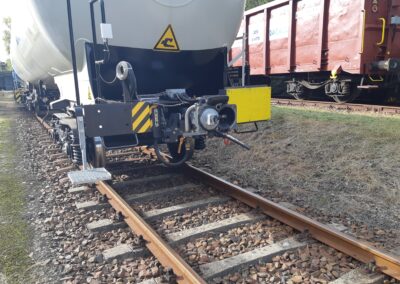
Focus on automation of wagonload traffic
In the Year of Rail 2021, modernisation through automation of wagonload traffic is at the top of our agenda. Our cooperation with the Federal Office of Transport (FOT) and the Association of Public Transport (VVO) for a joint approach to automation in rail freight transport is progressing according to plan. Among other things, the focus is on the Digital Automatic Coupling (DAK). The details of the joint tasks will soon be defined in consultation with the freight railways, wagon and locomotive operators and shippers, so that concrete progress can be seen soon.
Model evaluation underway
At the same time, the evaluation of the various DAK models is underway at the European level. We expect the decision for a specific system in autumn. After that, the corresponding implementation plan should be presented at the EU level. In other words, the DAK and with it automation in rail freight transport are taking shape.
Funding needed
The modernisation of rail freight transport requires clear political and financial support. This is why our President and Member of the Council of States Josef Dittli started the corresponding political process with the motion 20.3221 «Transporting goods more efficiently by rail through automation». By accepting the motion, Parliament has entrusted the Federal Council with the preparation of a concept.
Implementation concept envisaged
We at the VAP, together with the FOT and the VöV, will therefore tackle a concept and submit it to parliament for consultation in due course. This concept should contain the technical solution, a transformation plan and the initial costs with the expected efficiency increases. It will be up to parliament to decide on the financial support and suitable framework conditions (streamlining of the statutory safety and working regulations, adoption of the European interoperability regulations, etc.).
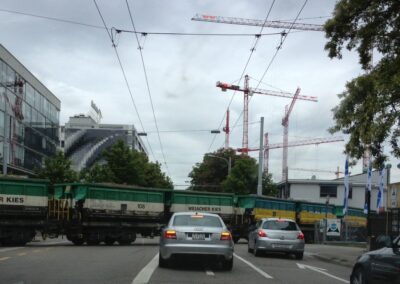
Combined transport and multimodality (Part 2)
In addition to the federal government, the cantons and large Swiss cities are also increasingly defining holistic freight transport concepts for their efficient, safe and environmentally friendly supply and disposal of goods. The freight transport industry is striving to work in partnership with the cantons and cities in order to join forces and further develop logistics locations. City logistics within cities and conurbations is becoming increasingly important. We at the VAP consider the following measures to be necessary so that the strengths of rail freight transport can be brought to bear in combined and multimodal transport.
1. Infrastructure development
- Dedicated investments in line extensions for freight transport are necessary for long-term competitiveness. It is imperative that these be included in the work for the next STEP expansion stage 2040/45, namely:
- Planning and implementation of the Zurich freight bypass line for additional capacity and unbundling of passenger and freight traffic, including elimination of bottlenecks in the nodes between Aarau and Winterthur.
- Examination of the complete unbundling of freight and passenger traffic in the Basel, Geneva and Zurich-Winterthur area as well as the Lausanne junction.
- The Swiss road network is in urgent need of modernisation. The measures adopted by the Federal Council and Parliament within the framework of the new National Roads and Agglomeration Transport Fund (NAF) and the strategic development programme STEP National Roads must be implemented as quickly as possible. There is a need for both renovations and the elimination of bottlenecks and capacity expansions on the most congested stretches.
- The coordination of the superordinate and subordinate road network must become the focus of attention. This means that more resources in the cities and agglomerations must be used directly for the specific needs of city logistics than is the case in agglomeration programmes 1 and 2.
- For comodal solutions in import/export, the transhipment capacities in Ticino must be significantly increased. To this end, existing terminals should be expanded and additional new locations near the border should be evaluated.
- Logistics locations must be taken into account in spatial planning and made more accessible: This includes access by road (national, cantonal, municipal roads), access by rail (network capacity to the (receiving) station) and shunting capacity for access to the siding from the (receiving) station. The latter is currently not legally secured. Regional network plans would be decisive for this.
2. Regulatory framework for the road
- The current road regulations should be retained in their entirety. The HVF, the ban on night and Sunday driving for HGVs, the 40-tonne weight limit and the ban on cabotage are undisputed in the transport industry and ensure fair social and competitive conditions.
- The cabotage ban in particular is central. Any relaxation of the current regulations would threaten the existence of the entire Swiss transport industry on rail and road. In addition, fatal consequences for the environment and modal shift policy would have to be reckoned with. In the current process on the possible conclusion of an institutional agreement, the ban on cabotage must therefore not be tampered with. It must remain anchored in the existing land transport agreement in its current form.
- As a financial incentive for multimodal transport, the HVF reimbursement in combined transport on the initial or final road leg should be additionally increased and now also granted for the combination of road and rail in wagonload transport with goods instead of container transhipment.
- The (road) transport industry abroad works with completely different cost structures than Swiss transport companies. The biggest differences are in the remuneration of drivers. The result is so-called “social dumping”, which massively distorts competition in the highest-volume freight transport markets in Europe. In addition, there is a need for tighter controls on the existing cabotage ban, including massively higher fines in the event of infringements.
3. Regulatory framework conditions for the railways
- In order to use infrastructures for passenger and goods trains as efficiently as possible, network utilisation concepts should be further developed in line with demand. In this way, expensive investments in infrastructure can be avoided and nodes can be effectively relieved. The freight transport industry is prepared to dynamise demand, for example in north-south traffic, thanks to hourly or daily planning. In return, the freight transport companies demand a discussion regarding the use of train paths by freight and regional trains at off-peak times early in the morning and late in the evening.
- Maintenance concepts of the infrastructure managers must take more account of the needs of freight traffic at night. The compensation introduced for line closures due to construction sites is useful as compensation, but ultimately the loading industry needs more reliability in the freight railways’ service provision. In future, maintenance work should therefore also be planned increasingly during the day and at weekends with uniform restrictions for all modes of transport.
- In order to strengthen the competitiveness of the railway in co-modal transport chains, the marginal costs of infrastructure use per train travelled must be redefined, taking into account the different demands of passenger and freight transport.
Entrepreneurial commitment
Freight railways, road hauliers and the shipping industry are aware of their responsibility for the supply of goods in Switzerland and have already implemented various measures in favour of co- or multimodal freight transport solutions.
- The partnership between SBB Cargo and Swiss Combi strengthens the shift from road to rail and sustainably increases capacity utilisation in system wagonload traffic and combined transport. The aim is to further increase the competitiveness of rail in the customers’ logistics chain and to use the modes of transport according to their strengths.
- SBB Cargo, the VAP VAP Swiss Rail Shippers Association and the Association of Public Transport VöV are developing a joint view of the range of services offered by the freight transport industry. Within the framework of the STEP 2030/35 expansion step, demands such as sufficient capacities, faster train paths and upgrading and new construction of freight transport facilities and stations were pushed through.
- Road freight transport is continuously increasing its efficiency through internal optimisations (e.g. planning, dispatching, digitalisation). The number of unproductive empty runs is at a very low level. However, a considerable part of the efficiency gains achieved is lost again due to productivity losses as a result of increasing congestion on the entire road network.
More dialogue for more sustainability and efficiency
Switzerland’s transport companies and shippers are committed to sustainable and efficient freight transport as a contribution to an ecological and competitive Switzerland. The modal shift from road to rail in transit traffic from border to border and a sensible (multi-) modal split should be further strengthened. The VAP and its partner organisations support a partnership-based, dynamic relationship between the authorities and industry players and are prepared to participate actively in the work.
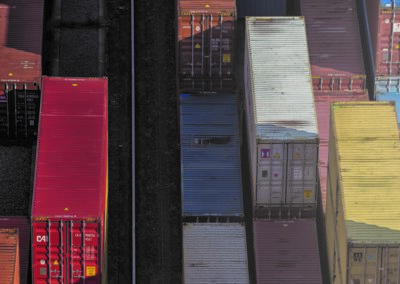
Combined transport and multimodality (Part 1)
The transport companies on road and rail as well as the shipping industry take their economic, ecological and social responsibility seriously and rely on cross-modal solutions. They combine the Rhine, road, rail, inland waterways, pipelines and air freight to create needs-oriented multimodal logistics solutions.
Conceptual
Combined transport in the narrower sense combines different modes of transport (road, rail, water) in one system. In this process, it is not the transported goods that are reloaded, but a transport container – in most cases a container. The majority of the distance covered (main leg) is to be covered by rail or ship, and the pre-carriage and onward carriage by road are to be as short as possible.
Multimodal transport in the broader sense also combines different modes of transport. However, the goods to be transported are reloaded when the mode of transport is changed, usually from ship and rail to truck and vice versa. Combined transport does not meet the requirements of the general cargo business in particular. This is why the rapidly growing general cargo traffic is predestined for multimodal transport, as the collection and distribution can take place more flexibly on the road than in combined transport. The latter presupposes a destination-specific load for all goods in the container. In Cargo Domicile alone, 300 freight wagons are transported in such traffic every night. Accordingly, rail freight transport plays a key role as a means of mass transport in both combined and multimodal transport. Proven subsidies (flat-rate reimbursement of the HVF, 44t limit in pre/post-carriage) should therefore be extended to all combinations of road and rail – regardless of their concrete design.
Combined transport on the rise
Combined transport has gained in importance in recent years due to its unprecedented promotion through subsidies, toll reductions and weight increases for HGVs (cf. Figure 1). In transit through Switzerland, 85.3% of the tonnages transported in 2019 were in combined transport (cf. Figure 2). In import and export traffic, 7.6% of the tonnages transported were in combined transport. In domestic transport it was 7.1% of the tonnages transported.
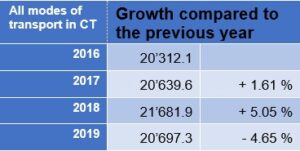
Figure 1: Growth of combined transport 2016 to 2019 1
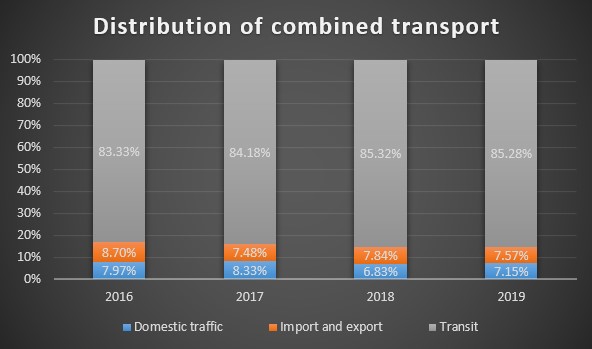
Figure 2: Percentage breakdown of combined transport2
Around one third of all rail freight is carried by combined transport. In rail transport, it came to a share of transported tonnages of 34% in 2019 and 12% for inland navigation to and from Basel. The share of net tonnes transported in unaccompanied combined inland transport is 8%. The corresponding figure is much lower for road transport, which – as mentioned – is only used for the so-called pre-carriage and onward carriage (average transport distance of around 50 kilometres). Here, the CT share in 2019 was 2%, whereby this figure only refers to transports with domestic vehicles. The remaining goods are transported via conventional transport in freight wagons with transhipment of goods instead of containers.
Freight transport volume on the rise
The volume of goods transported on Swiss infrastructures will increase by 37% by 20403. The biggest driver is the growth in domestic traffic with an increase of 39%. Due to population and economic growth, division of labour, digitalisation and e‑commerce, small lot sizes in the form of courier, express and parcel services in particular will grow disproportionately. The volume of transit freight transport is also growing continuously and will increase by 38% by 2040 compared to the 2010 reference value.
Implementation of the constitutional mandate to shift traffic in transit
With the constitutional article on the protection of the Alps («Alpine protection article») adopted in 1994, the shift of freight traffic to rail in transit was enshrined in the constitution. Since then, Switzerland has invested a great deal in this shift. The construction of the Neat, to be completed in 2020 when the Ceneri base tunnel comes into operation, cost CHF 18.5 billion. The compensation for combined transport between 1994 and 2020 (until 2023) totalled CHF 1675 million4. By 2026, a further CHF 90 million will be paid to keep combined transit traffic on the railways. Today, rail has a market share of over 70% in transalpine transit freight transport from border to border through Switzerland, which is unique in Europe.
1 Cf. Swiss Federal Statistical Office, Combined goods transport, 2021
2 Cf. Federal Statistical Office, table Combined goods transport by rail
3 Cf. «Transport Outlook 2050», Federal Office for Spatial Development (ARE)
4 Cf. Federal Council Dispatch 2019 (in german)